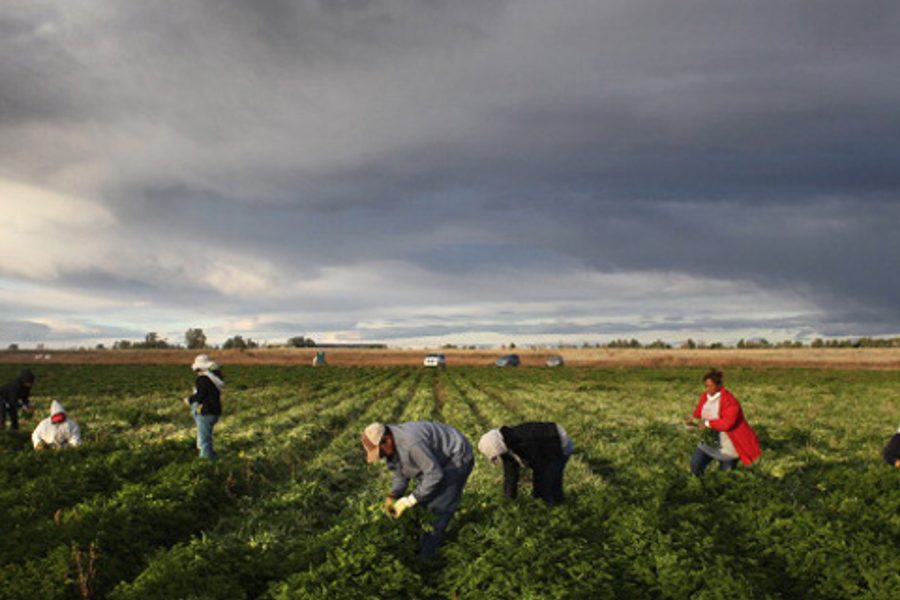
Last month public health advocates and researchers from around the world convened at the International AIDS Conference in Washington, D.C. to discuss the state of the crisis. But many of the communities most affected were not in the room. Some, like sex workers, were explicitly barred from entering the country. Others were excluded by their economic and political circumstances. Far from the conference, the country’s farms are quietly stalked by the HIV/AIDS epidemic, but struggling migrant farmworkers may not realize they’re at risk until it’s too late.
HIV is one of a myriad of health issues facing migrant farmworkers, but it’s unique in that so little is known about the scope of the problem. Farmworkers are typically cut off from regular social welfare programs and lack insurance, and there are deep gaps in research about HIV prevalence in this population.
Access to healthcare is virtually out of reach for workers tied down by systemic exploitation. The most marginalized farmworkers, the vast majority of them Latino, face high risks of job-related illnesses and injury, abusive working conditions and, frequently, sexual violence against women.
The most recent research that focuses specifically on farmworkers and HIV is alarming, but sparse. A Centers for Disease Control investigation of about 300 farmworkers in Immokalee, Florida, (an area notorious for labor exploitation on tomato farming operations), found a prevalence rate of 5 percent. Other studies have found rates ranging from less than half a percent to 13 percent. Overall, the new HIV infection rates for Latino men and women are especially high compared to those for the white population. The bottom line is that there is a dire need for more in-depth research.
Underlying all of these risks for sexual health are poor living conditions that many Americans would be shocked to encounter in this country. The advocacy group Migrant Health Promotion reports:
Conditions such as tuberculosis, malnutrition, parasitic diseases and scarlet fever occur more frequently among farmworkers than among the general United States population. Poor dental health, substance abuse, mental health problems, domestic violence, diabetes and hypertension are also prevalent among farmworkers.
When even the most basic health resources are out of reach, sensitive issues like sexually transmitted diseases – which are typically shrouded in stigma and misinformation even among more stable or affluent populations – may well remain buried under the everyday struggles with poverty and social isolation. Farmworker Justice, an organization that provides outreach and prevention programs for workers, points out that many social barriers to healthcare are aggravated by a hostile social climate of anti-immigrant crackdowns.
According to Farmworker Justice, the nature of migrant farmwork exposes them to acute risks. In addition to social risk factors like depression, there appears to be a relatively low rate of condom use among both men and women.
An analysis by the National Center for Farmworker Health (NCFH) notes that a study of male migrant farmworkers in San Diego “found that 70 percent of sexually active farmworkers reported sex with a sex worker, of which only 23 percent reported using condoms.” Similarly, a 2003 study of Mexican migrant women “found that of respondents who had two or more sexual partners, only 25 percent reported using a condom during sex.”
Moreover, risky sexual behavior is linked to patterns of mobility and separation of couples that are endemic to migrant farmwork. The NCFH notes that there may be a link between HIV infection of migrants, return border-crossings, and rising infection rates in Mexico.
Exposure to HIV may also be heightened by stigma and lack of awareness. A 2007 study of farmworkers in New York revealed widespread misconceptions about HIV risk, with about a third saying they thought “HIV is no longer a serious problem in the United States.”
In a correspondence with ITT, Jessica Felix-Romero, director of communications at Farmworker Justice, says that even if infected farmworkers have been diagnosed with HIV, they may find it extremely difficult to cope with medical needs due to their high mobility:
Farmworkers can face serious challenges in getting access to the continuous care needed in managing the disease. They contend with non-traditional work hours, transportation difficulties getting to services from isolated rural zones, and affording or consistently receiving treatment medications especially if they migrate to follow different crops around a particular region or across the country.
Given the volatile and hostile tone of the U.S. immigration debate, it’s important to approach this from a public health standpoint. While fear of “disease” is often invoked in racist nativist arguments, those stereotypes severely distort the real picture of HIV as a transnational public health crisis.
The banishment of certain activists from the International AIDS Conference reflects how fear-driven discrimination can shape immigration barriers (a blanket ban on immigrants with HIV/AIDS was only recently repealed). The same tensions drive the marginalization of immigrants in the United States. The public health ramifications of migration need to be understood not in terms of exclusion but inclusion, involving all the communities where migrants live, work, return to or resettle.
Over the past generation, advances in addressing the HIV/AIDS epidemic have come through shifting toward a more global, holistic approach to public health. But that response still hasn’t reached people at the margins of the crisis, because their health risks reflect an underlying malady of social exclusion.
Michelle Chen is a contributing writer at In These Times and The Nation, a contributing editor at Dissent and a co-producer of the “Belabored” podcast. She studies history at the CUNY Graduate Center. She tweets at @meeshellchen.








